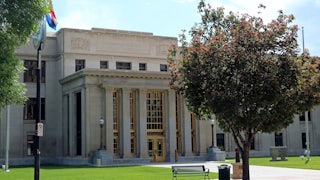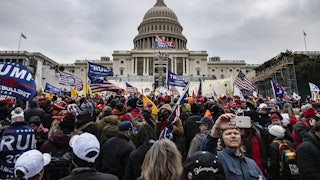At a rally in Wildwood, New Jersey, on Saturday, former President Donald Trump gave a 90-minute stemwinder in which he praised Hannibal Lecter—a fictional cannibalistic serial killer, mind you—as a “wonderful man” and, in nearly the same breath, disparaged immigrants as “people who are being released into our country that we don’t want.” He also bemoaned the “sham” hush-money trial that consumes his weekdays, mocking “Fat Alvin” Bragg (the Manhattan district attorney who indicted Trump in the case) and “corrupt” Juan Merchan (the New York Supreme Court judge presiding over the trial).
It was a typical Trump rally, in other words: never-ending, extemporaneous, aggrieved, and strewn with imaginative lies and crude insults.
But on Monday morning, Trump lumbered back into that dingy Manhattan criminal courtroom and sat down at the same wooden table where he has sat, hunched over and flanked by his lawyers, for nearly a month now. This is the man the public doesn’t get to see, but which I have been privy to as a journalist in the room, covering the trial. It is quite rare, even profound, to witness: a silent, lethargic Trump.
Thanks to regulations dating back to the 1935 kidnapping trial of Charles Lindbergh’s baby son, New York state courtrooms have some of the most restrictive media coverage rules in the country. In fact, earlier this week, as I waited with fellow members of the press to enter the courthouse at 100 Centre Street, I overheard a reporter pleading with a court media liaison to at least allow cameras to film the verdict, for history’s sake. But the liaison could make no such promise.
And so, aside from a handful of curious tourists and New Yorkers willing to line up at an ungodly hour or shell out hundreds of dollars to hire a line sitter, the public’s perception of this trial will be filtered through the eyes of the press. Unfortunately, these secondhand accounts provide an incomplete rendering.
Much of the trial coverage so far—and, by extension, the public’s view of it—has focused on Trump’s tantrums inside the courtroom and his bluster outside of it, violating the judge’s gag order and grandstanding for the cameras. But, as I sit in 100 Centre St, day after day, hour after hour, often just a few rows behind the defendant, I’m struck not by Trump’s words but by their absence.
With the exception of two outbursts, including one in jury selection and another during Stormy Daniels’s testimony, Trump has mostly faded into background. Much like the defense table at which he sits, the defendant has become part of the furniture. He’s usually so quiet that I have to remind myself periodically to look over at the former president for any sign of reaction or movement. Disappointed, I often find him in a familiar pose: eyes closed, head tilted slightly upward, his hands in his lap.
As part of a press corps that, for better or worse, publishes a lot of what Trump says, I am not used to seeing this famously loud man stay so quiet for so long. I first took note of this odd sensation during jury selection, when potential and permanent jurors alike had an opportunity—or rather, a legal requirement—to tell Trump directly to his face how they felt about him. Many of these sentiments were less than flattering, though Trump could not respond as he most surely wanted to—and would have done in other settings.
Though we are still likely a couple weeks away from a verdict, Trump’s silence is already a testament to the rule of law. Not even the lawless demagogue can have his way in Merchan’s courtroom. Instead, Trump is robbed of his most powerful weapon—his voice—as he submits to the authority of the justice system.
To be sure, Trump has not stayed completely silent. During jury selection, Merchan chastised Trump for muttering audibly in the direction of a juror who was answering questions just feet away. Lead defense counsel Todd Blanche then whispered something in his client’s ear. Trump must have received the message because for the remainder of jury selection, he was docile. So docile, in fact, that the media began to speculate as to whether he was sleeping during the long stretches he spent with his eyes closed—speculation that has plagued him ever since.
The next outburst did not come until weeks later, during Daniels’s testimony, but even that episode was overstated. At one point, reports indicated that Trump appeared to say, “That’s bullshit.” I was seated just a few rows back, but I didn’t hear it.
Again, this outburst was an outlier. Trump was silent when Daniels offered uncomfortable details of her sexual encounter with him (all of which Trump denies), details which verged on sexual assault or coercion. He remained silent as Michael Cohen, his former fixer, further betrayed him from the stand. He remained silent as former and current members of his inner circle told story after story of his infidelities and avarice.
Even the reporters stationed in the hallway outside the courtroom often see the same uncanny version of Trump, who ignores their questions as he comes and goes, only mustering a half-hearted wave or raised fist.
The closest I’ve seen a firsthand observer get to conveying the sensation I’m trying to describe here is from the talented courtroom sketch artists who observe Trump closely every day. In a recent interview, Christine Cornell described the challenge of drawing Trump at the defense table. “He’s being isolated,” she explained. “You know, he likes people’s adulation. He feeds off it.” But instead, especially during the trial’s many sidebars, as lawyers from both sides gather round the bench in hushed discussion with Merchan, Trump sits alone at the defense table, having waived his right to be present at the conferences earlier in the trial. Sitting there with his eyes closed, empty chairs beside him, his silence somehow grows more pronounced.
Trump lives for the spotlight, but only so long as he’s directing the scene. On trial, he is both the center of attention and a bit player: a criminal defendant whom everyone in the courtroom is watching, but also a mute observer of his own unfolding fate.
Of course, Trump could break his courtroom silence should he so choose, by taking the witness stand. But this is no rally; those 12 jurors are not his MAGA faithful. And so, he will continue to just sit there, his eyelids drooping, and do the impossible: shut up.






